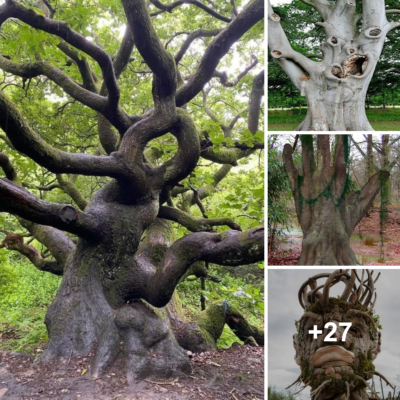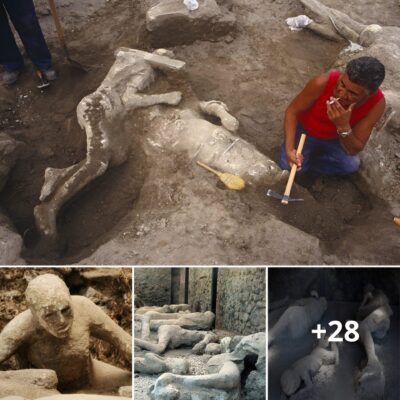Egypt, the land of pharaohs, pyramids, and ancient mystique, has captivated the human imagination for centuries. At the heart of this fascination are the treasures and artifacts left behind by one of history’s most remarkable civilizations.
Egyptian history stretches back over 5,000 years, and during this extraordinary journey through time, countless artifacts have been unearthed, revealing the genius, spirituality, and artistic mastery of the ancient Egyptians.
From colossal statues to finely decorated coffins, and from monumental pyramids to intricate hieroglyphs, these artifacts represent the myriad facets of a civilization that thrived along the banks of the Nile.
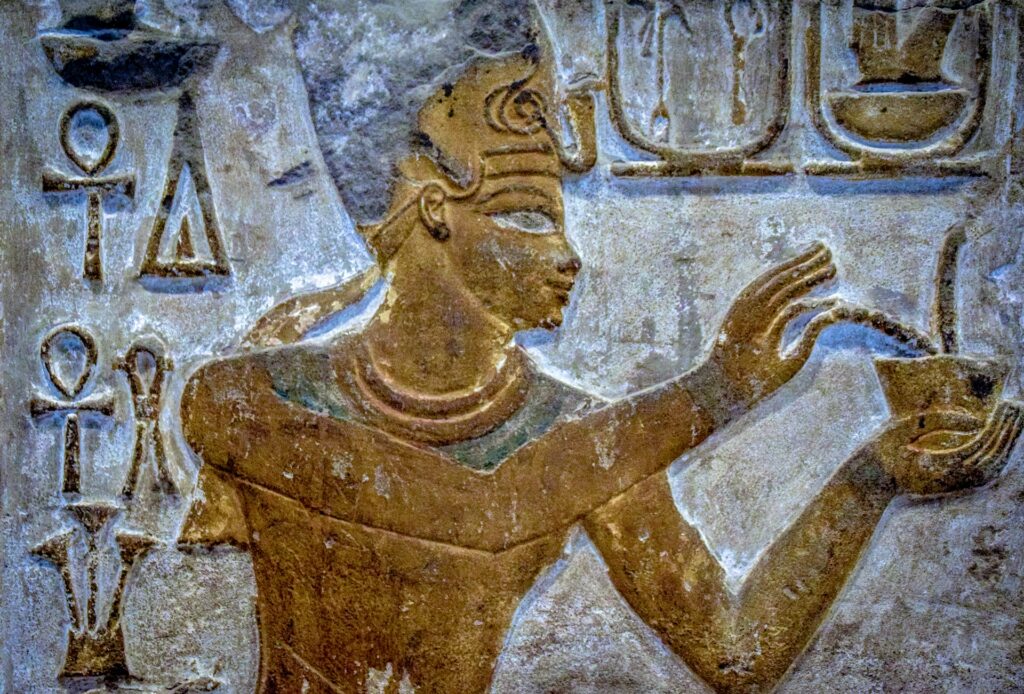
In this article, we embark on a mesmerizing journey back in time, as we explore “The Top 20 Ancient Egyptian Artefacts.” Each of these treasures serves as a portal into a world where art, religion, and history converged in unparalleled splendor. These artifacts include monumental structures such as the Great Sphinx and the Pyramids of Giza, as well as intricate objects like the Rosetta Stone and the Book of the Dead.
From the divine guardianship of Sekhmet to the intriguing history of the Abydos King List, we’ll delve into the profound cultural and spiritual significance of each item. Join us as we uncover the enduring legacies of these ancient wonders, allowing us to piece together the intriguing puzzle of Egypt’s past.
1. The Rosetta Stone: Deciphering Ancient Egypt’s Secrets
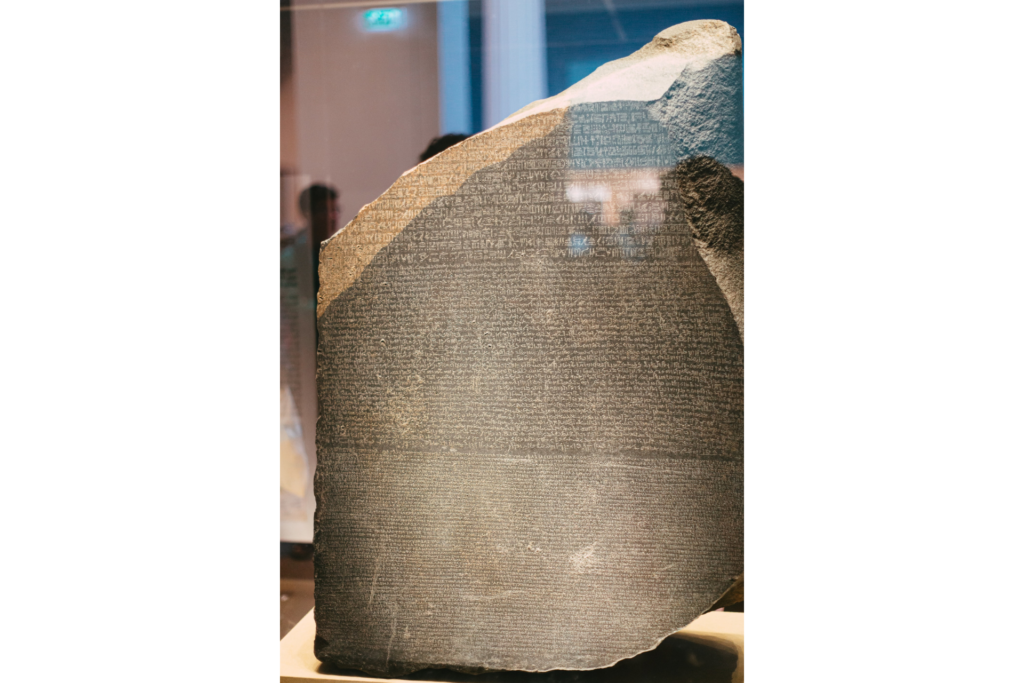
The Rosetta Stone, one of the most famous artifacts in the world, was discovered in 1799 during Napoleon Bonaparte’s Egyptian campaign by French soldiers. This invaluable artifact is believed to date back to 196 BC during the reign of King Ptolemy V Epiphanes.
What makes the Rosetta Stone exceptional is its inscriptions in three scripts: Greek, demotic, and hieroglyphics. It became the key to unlocking the mysteries of ancient Egyptian hieroglyphs, allowing scholars to understand this complex script for the first time.
The Stone’s discovery laid the foundation for modern Egyptology, enabling us to delve deep into the civilization’s literature, history, and culture.
2. The Great Sphinx of Giza: Guardian of the Pyramids
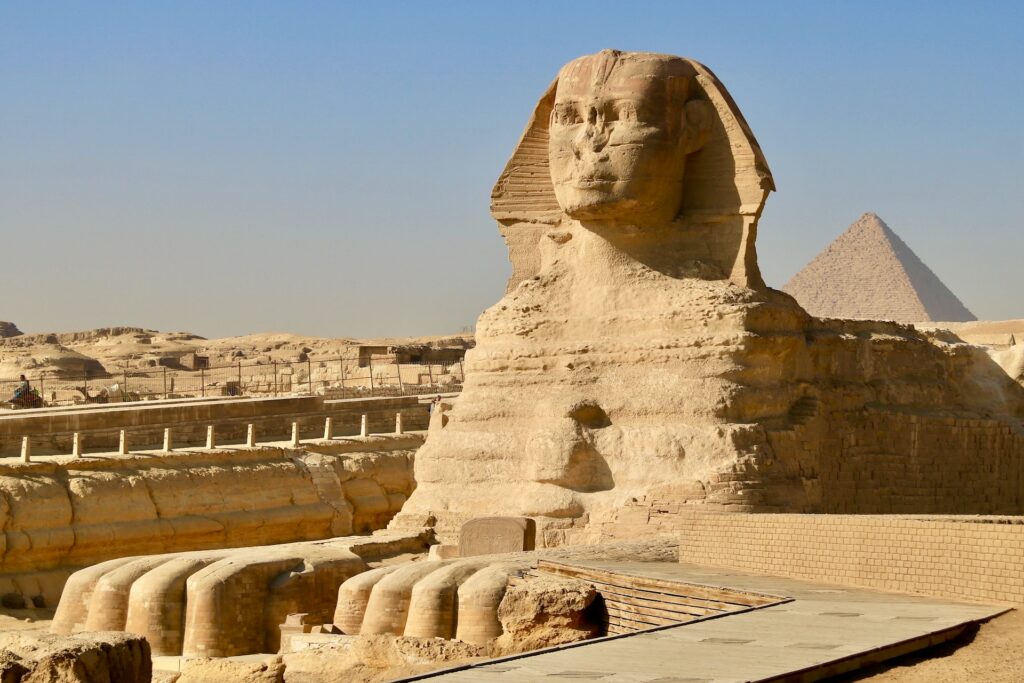
The Great Sphinx of Giza stands as an enduring symbol of ancient Egypt’s grandeur. Believed to have been constructed during the reign of Pharaoh Khafre around 2500 BC, this colossal statue represents a mythical creature with a lion’s body and a pharaoh’s head.
It guards the Pyramids of Giza, and its age and origin continue to captivate archaeologists and historians. Though time and erosion have eroded many details, the Sphinx’s enigmatic expression still captures the imagination, making it a testament to the architectural and artistic prowess of the ancient Egyptians.
3. The Book of the Dead: Navigating the Afterlife
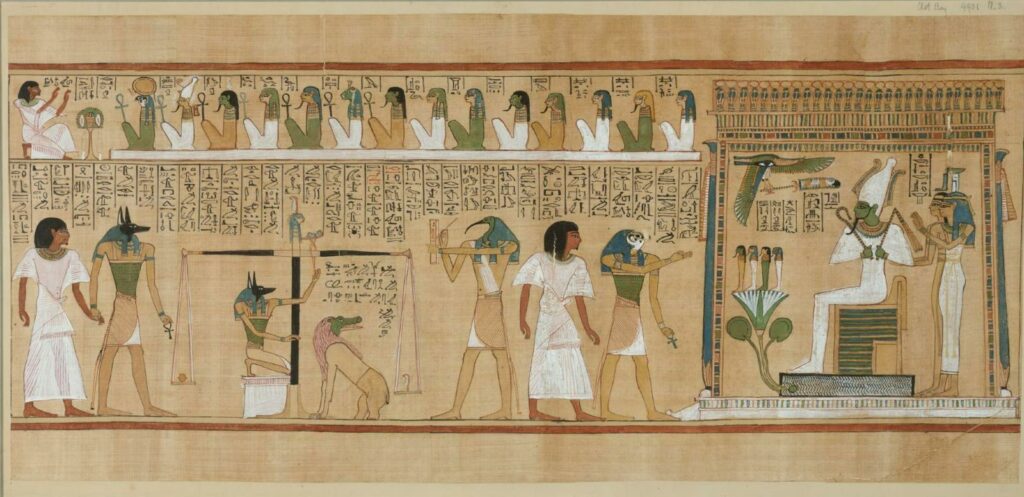
The Book of the Dead, known as “The Coming Forth by Day,” is a collection of funerary texts originating from the New Kingdom (1550–1070 BC).
These texts, often inscribed on papyrus scrolls, were placed in tombs to guide the deceased through the afterlife. They contain spells, incantations, and instructions to help the soul overcome various challenges in the realm of the dead.
These texts offer a unique insight into the beliefs and rituals surrounding death and the afterlife in ancient Egypt. The Book of the Dead is a testament to the Egyptians’ profound spirituality and their quest for eternal life.
4. King Tutankhamun’s Death Mask: The Face of Royalty
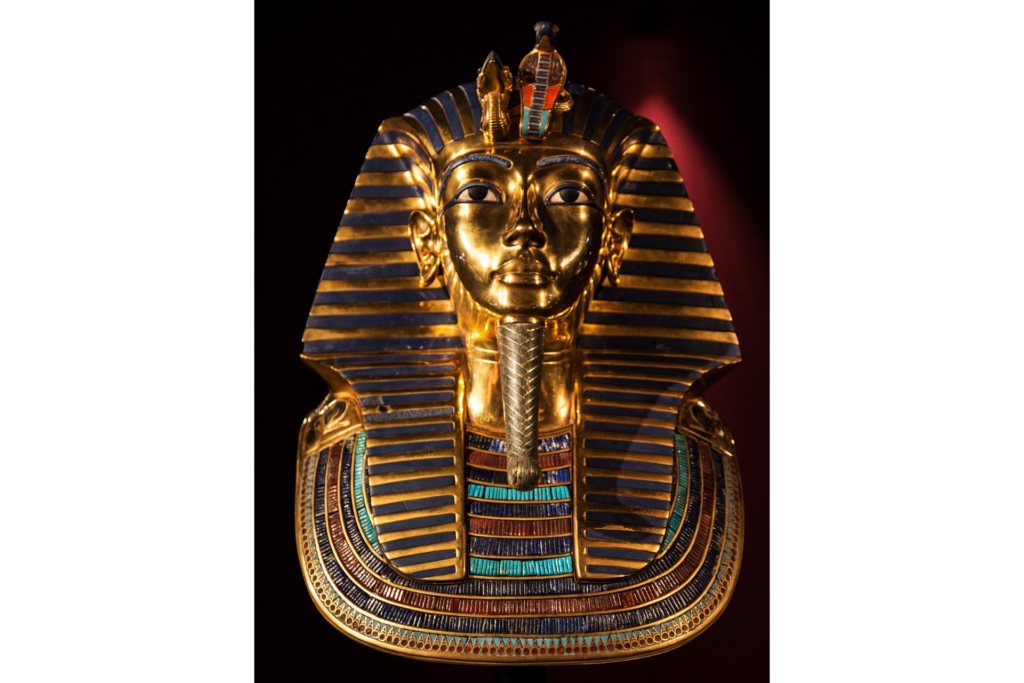
The discovery of King Tutankhamun’s tomb in 1922 by Howard Carter ranks among the most significant archaeological finds of the 20th century.
Among the treasures that lay within the tomb was the stunning gold death mask of the young pharaoh. The mask, believed to date back to 1323 BC, is a masterpiece of artistry and craftsmanship. It adorned the mummy of King Tut and remains a symbol of the riches and splendor of ancient Egypt.
This iconic artifact, with its lifelike features and intricate detailing, provides a glimpse into the world of Egyptian royalty and their reverence for the afterlife.
5. The Narmer Palette: Celebrating Ancient Egypt’s Unification
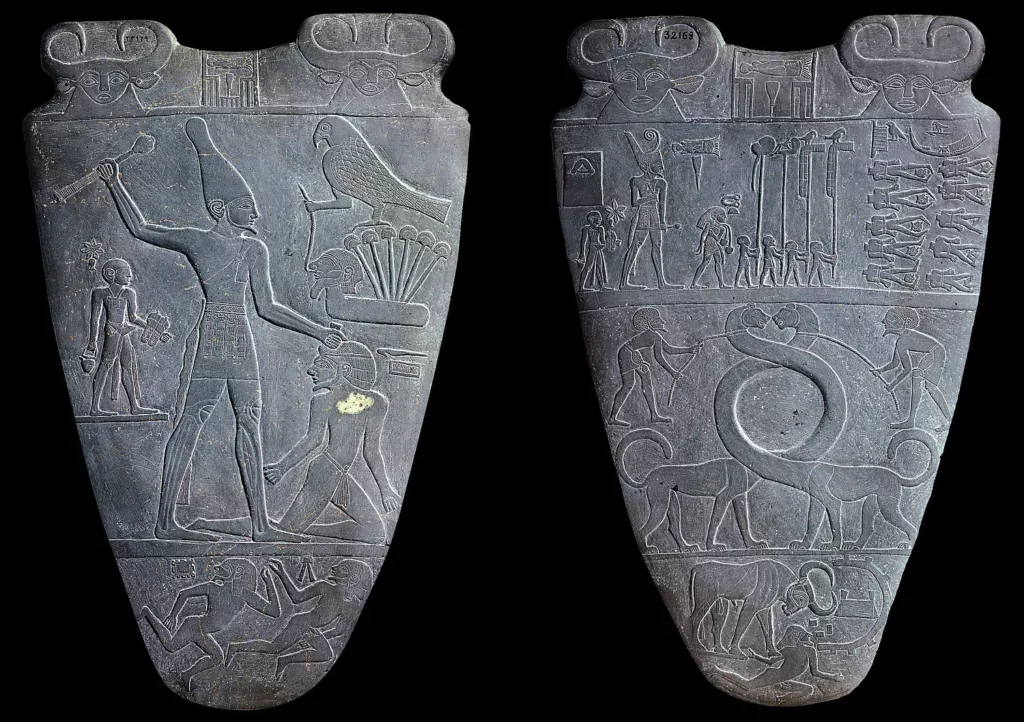
The Narmer Palette, an iconic artifact from ancient Egypt, was discovered in Hierakonpolis (modern-day Nekhen) and is believed to date back to around 3100 BC.
It is an ancient ceremonial slate palette that commemorates the unification of Upper and Lower Egypt under the reign of King Narmer, also known as Menes. This unification marked a pivotal moment in Egypt’s history, leading to the birth of a centralized Egyptian state and the establishment of the pharaonic civilization.
The palette’s intricate relief carvings depict Narmer wearing the White Crown of Upper Egypt and the Red Crown of Lower Egypt, symbolizing the unity of the two regions. The Narmer Palette serves as a historical milestone, shedding light on the political and cultural developments of ancient Egypt’s earliest days.
6. The Pyramids of Giza: Marvels of the Ancient World
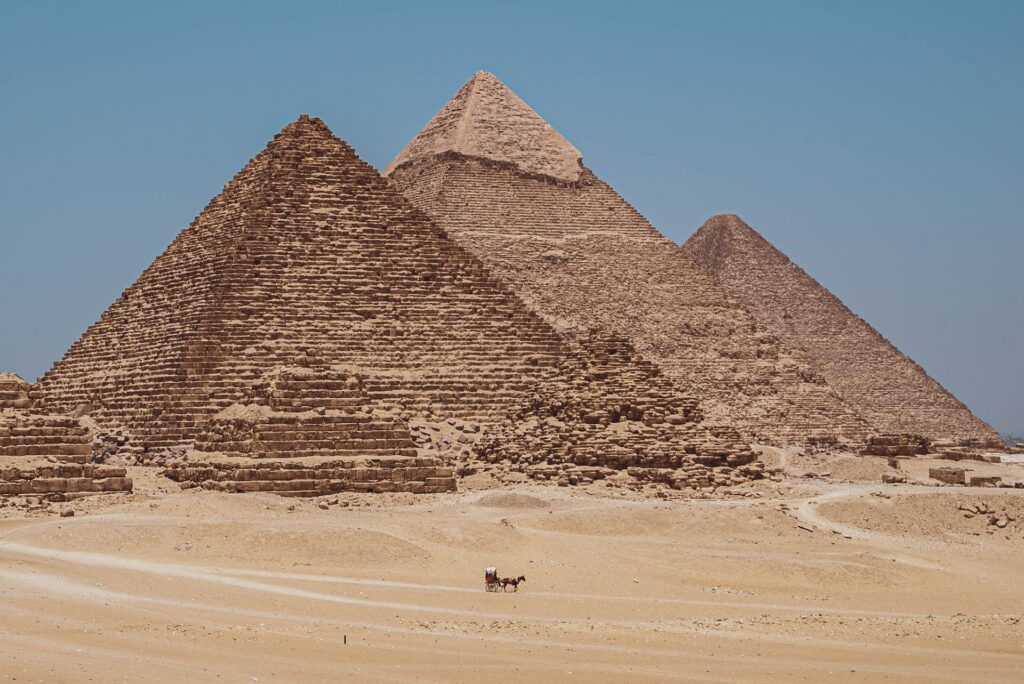
The Pyramids of Giza are the most iconic and enduring architectural wonders of ancient Egypt. These colossal structures, built during the Old Kingdom period (c. 27th century BC), continue to astound and mystify people worldwide.
The most famous of these pyramids are the Great Pyramid of Khufu, the Pyramid of Khafre, and the Pyramid of Menkaure. These monumental tombs, constructed as final resting places for pharaohs, showcase the Egyptians’ remarkable engineering and architectural skills.
The Great Pyramid, attributed to Pharaoh Khufu, is the largest and one of the Seven Wonders of the Ancient World. Its precision and grandeur have made it a symbol of human ingenuity and ambition.
7. The Colossi of Memnon: Guardians of Thebes
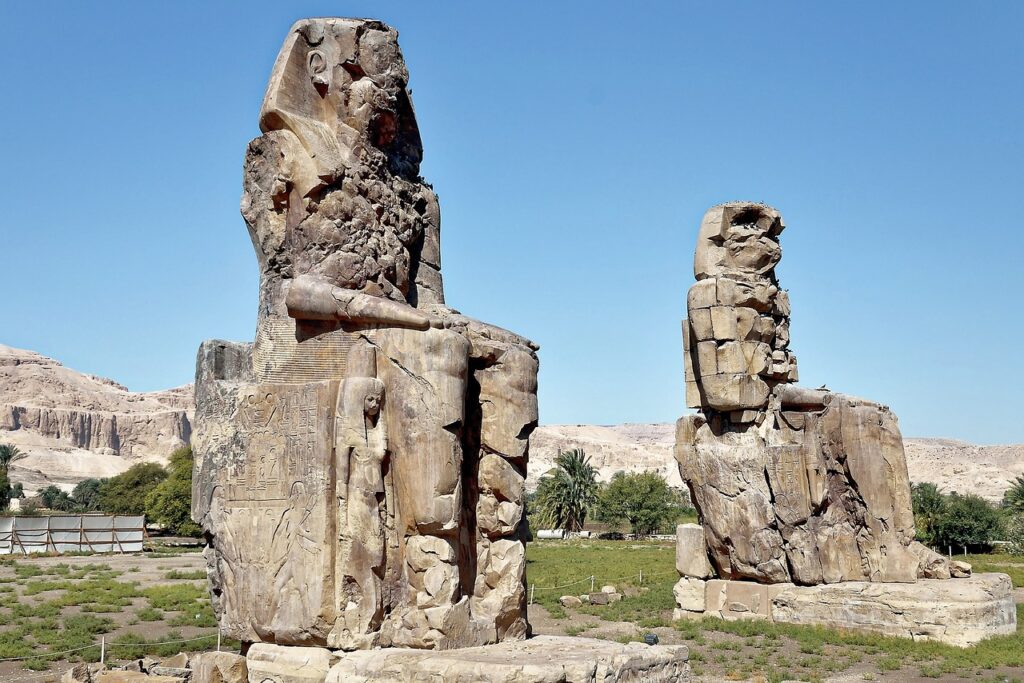
The Colossi of Memnon are massive twin statues of Pharaoh Amenhotep III, situated in the Theban Necropolis on the west bank of the Nile. These colossal statues, each standing approximately 60 feet tall, were constructed around 1350 BC during Amenhotep III’s reign.
They were originally positioned at the entrance of Amenhotep’s mortuary temple but have since lost much of their associated structure. The Colossi of Memnon have become famous not only for their colossal size but also for a peculiar phenomenon – they produce melodic sounds at sunrise due to temperature and humidity changes. This phenomenon has contributed to their legendary status and continues to attract visitors.
8. The Statue of Anubis: Guardian of the Afterlife
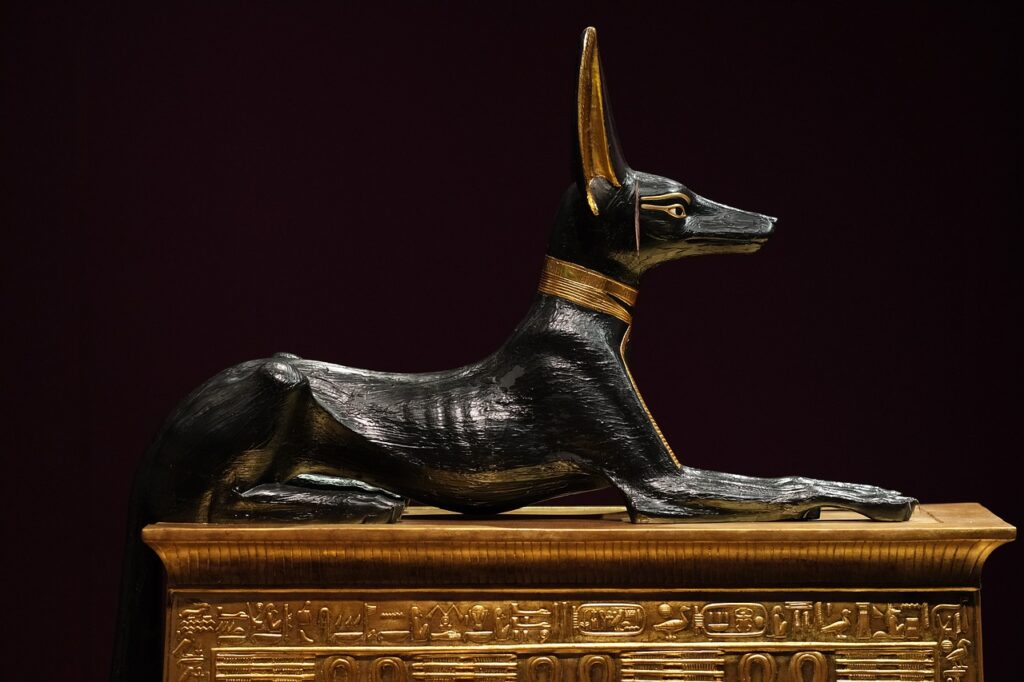
Anubis, the god of the afterlife, is often depicted as a jackal or dog-headed figure. Statues of Anubis were commonly placed in Egyptian tombs to protect the deceased and guide their souls in the afterlife. These statues, often made from various materials such as wood, stone, and bronze, date back to different periods in ancient Egyptian history.
Anubis played a vital role in the mummification process, ensuring the deceased’s safe passage to the afterlife. The god’s image represents both death and the transition to the next world, emphasizing the significance of religious beliefs in ancient Egyptian culture.
These statues not only serve as a symbol of spiritual protection but also provide valuable insights into the complex funerary practices of the time, shedding light on the ancient Egyptian concept of life after death.
9. The Canopic Jars: Safeguarding the Organs of the Deceased
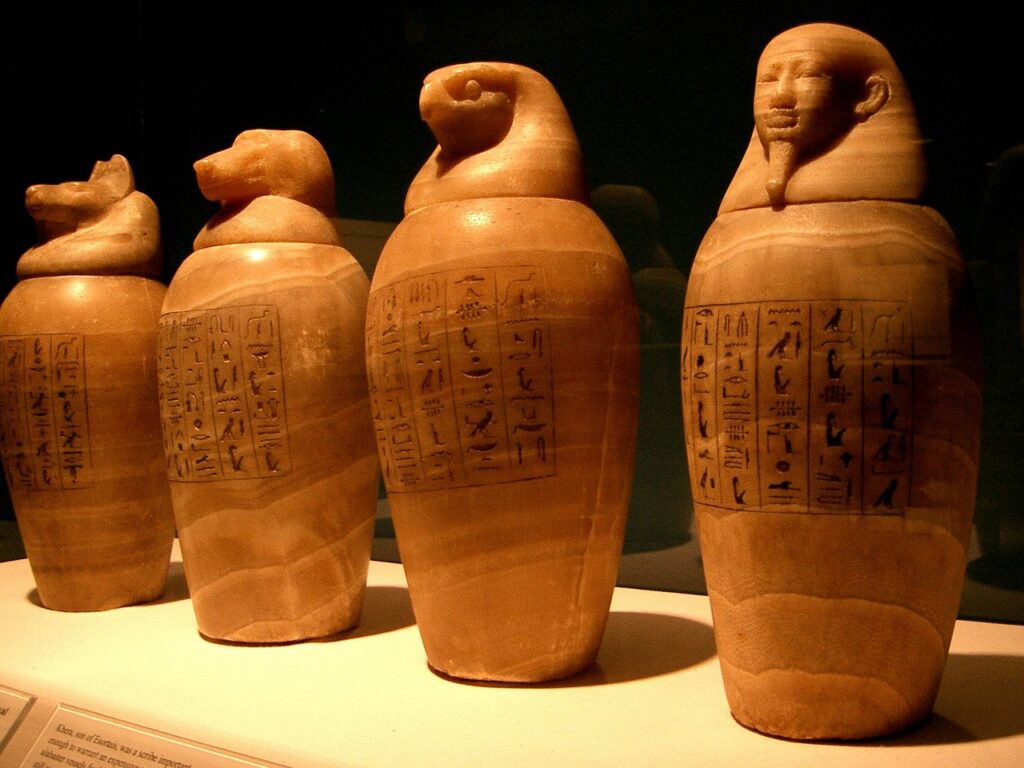
Canopic jars are a distinctive element of ancient Egyptian funerary practices, dating back to as early as the Old Kingdom (c. 2686-2181 BC).
These ornate containers were crucial in the mummification process as they were used to hold and protect the internal organs of the deceased. Each canopic jar typically represented one of the four sons of Horus, who were guardians of the organs: Imsety (liver), Hapi (lungs), Duamutef (stomach), and Qebehsenuef (intestines).
The practice of using canopic jars persisted for millennia, showcasing the Egyptians’ reverence for the afterlife and their commitment to preserving the physical and spiritual aspects of the deceased.
10. The Abydos King List: A Glimpse into Egypt’s Pharaonic Lineage
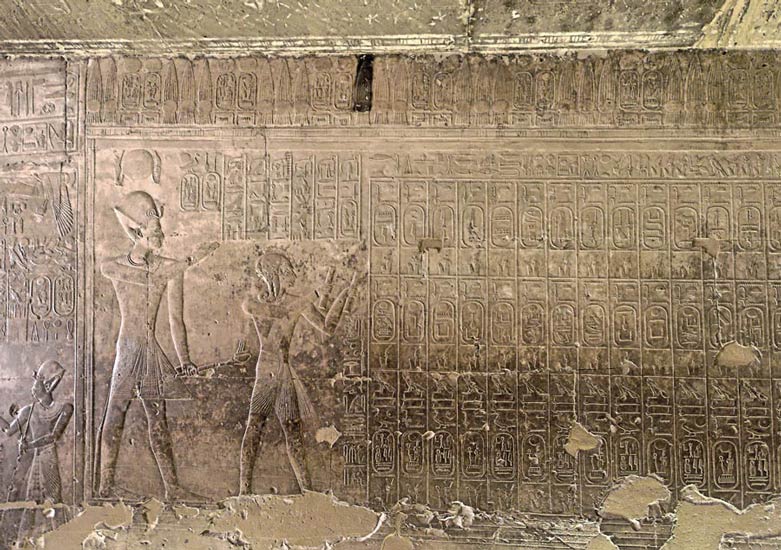
The Abydos King List is a priceless historical document carved into the walls of the Temple of Seti I at Abydos. Dating to the 19th Dynasty (c. 1292-1189 BC), this list provides a chronological account of Egypt’s pharaohs, beginning with the predynastic period and continuing through the early dynasties.
It is a testament to the meticulous record-keeping of the ancient Egyptians and their deep respect for the continuity of leadership. The Abydos King List has been invaluable in reconstructing the timeline of Egypt’s rulers and their dynasties, shedding light on the political and cultural evolution of this remarkable civilization.
11. The Temple of Karnak: A Monument to Divine Majesty
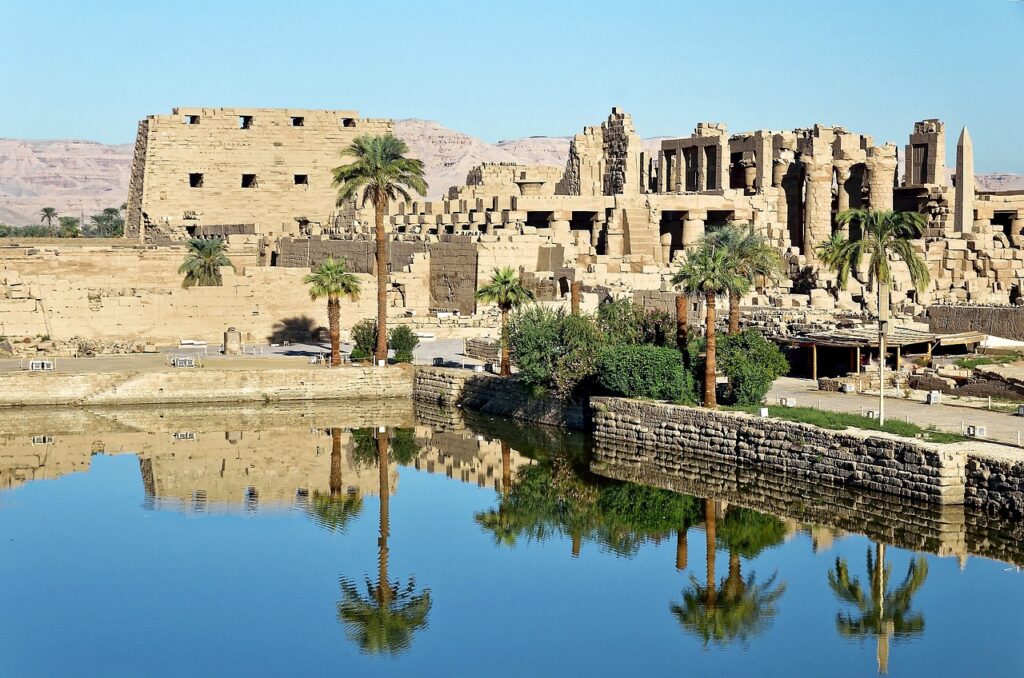
The Temple of Karnak is an awe-inspiring complex dedicated to various gods, with a primary focus on the deity Amun. This sprawling temple, located in Thebes (modern-day Luxor), was constructed over several centuries, beginning in the Middle Kingdom (c. 2055-1650 BC) and expanding through the New Kingdom.
Karnak represents a fusion of architectural styles and artistic innovations. Its grandeur is accentuated by colossal statues, towering obelisks, intricately decorated halls, and a sacred lake. It served as a center of religious worship, pilgrimage, and administrative activity.
This monumental complex stands as a testament to the religious fervor of the ancient Egyptians and their unwavering dedication to their pantheon of gods.
12. The Valley of the Kings: Royal Tombs of Eternity
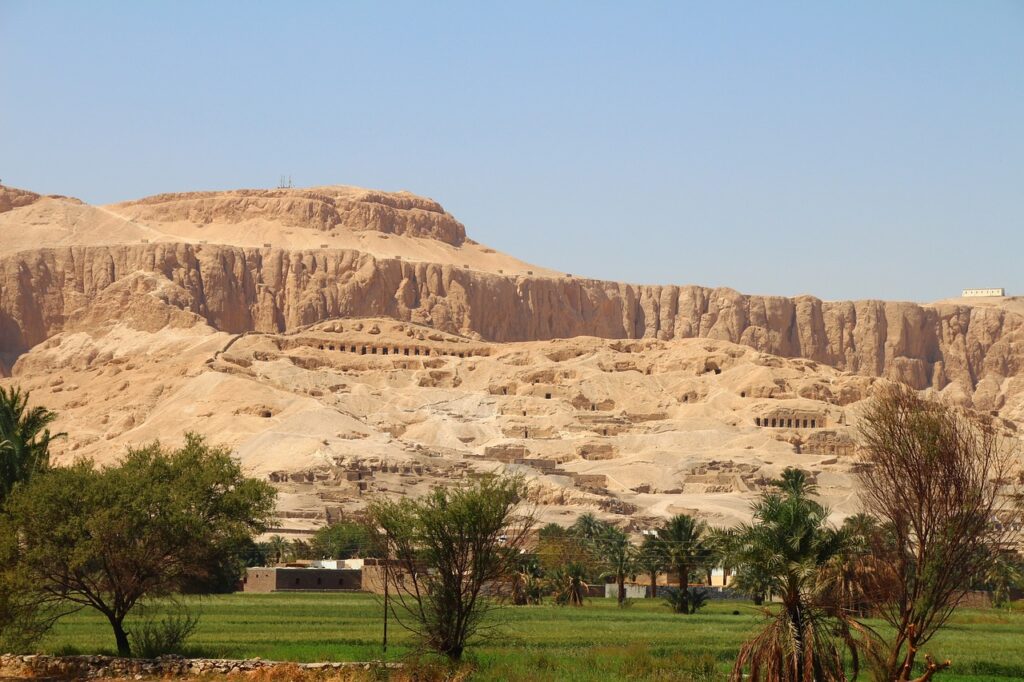
The Valley of the Kings, situated on the west bank of the Nile near Luxor, served as the burial site for numerous pharaohs and nobles during the New Kingdom period (c. 16th-11th centuries BC).
The Valley of the Kings is renowned for its rock-cut tombs, where the pharaohs of the 18th, 19th, and 20th dynasties were laid to rest.
It is an archaeological treasure trove, with its most famous occupant being the young Pharaoh Tutankhamun. The tombs are adorned with intricate hieroglyphs, detailed paintings, and precious artifacts, offering a remarkable insight into the religious beliefs and mortuary practices of ancient Egypt.
The Valley of the Kings, shrouded in desert solitude, is a testament to the Egyptians’ pursuit of eternal life and their determination to preserve the legacy of their rulers for all time.
13. The Step Pyramid of Djoser: The Birth of Pyramid Architecture
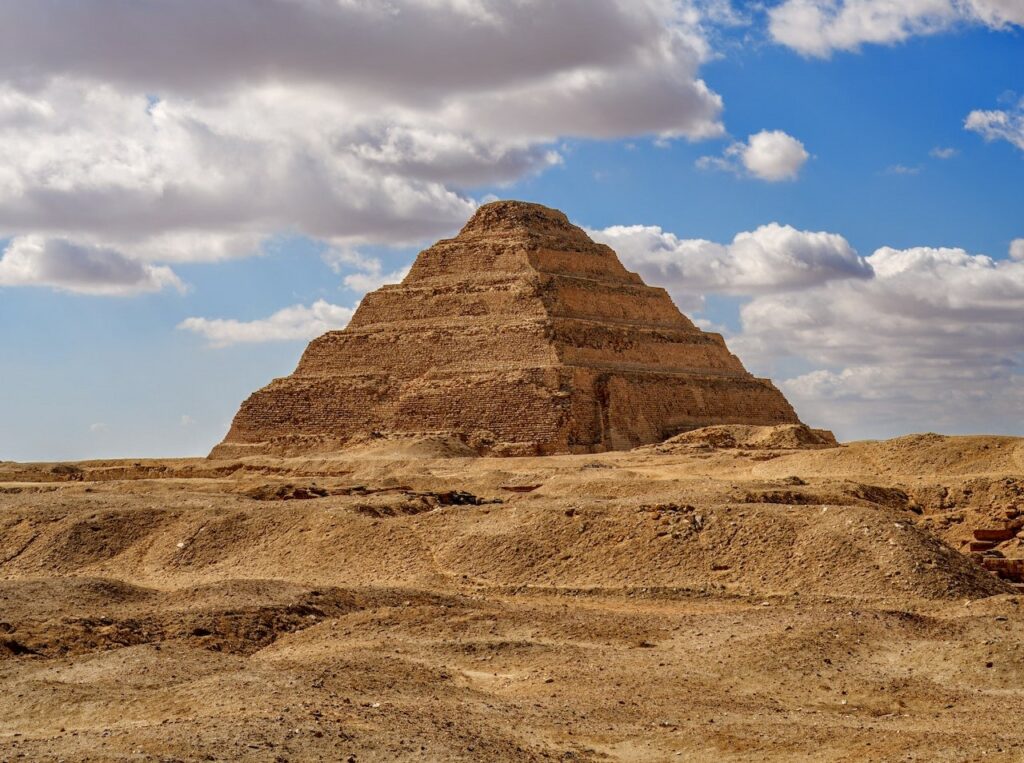
The Step Pyramid of Djoser, situated in Saqqara near Memphis, Egypt, is one of the earliest pyramid structures in Egypt. It was designed by the legendary architect Imhotep during the 27th century BC, marking a pivotal moment in architectural history. This groundbreaking pyramid is a series of six stepped layers, resembling a colossal wedding cake, and originally stood at approximately 6 tiers high.
It served as the final resting place for Pharaoh Djoser and represents the transition from mastaba tombs to true pyramids. Imhotep’s innovative design not only signified a pharaoh’s ascent to the afterlife but also symbolized the divine attributes of the king.
14. The Temple of Luxor: A Grand Ode to the Gods
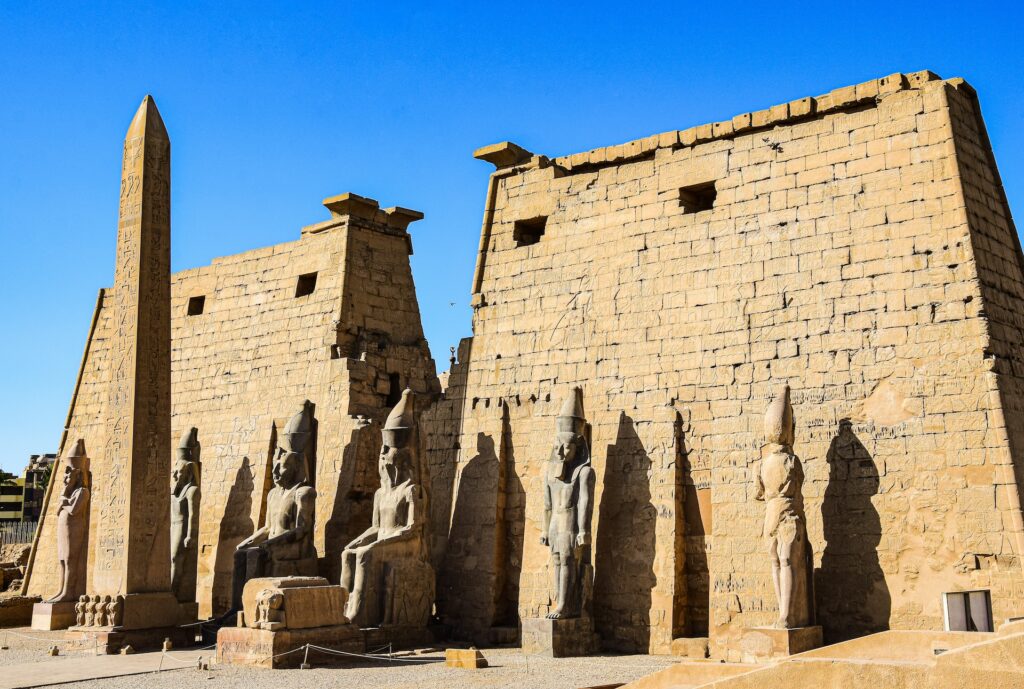
The Temple of Luxor, located on the east bank of the Nile in modern-day Luxor, is a vast and grand temple complex that dates back to the New Kingdom period, with construction spanning several dynasties. The temple was primarily dedicated to the god Amun, his consort Mut, and their son Khonsu.
The grandeur of Luxor is epitomized by its monumental entrance, the Avenue of Sphinxes, and its majestic obelisks. Notable pharaohs, including Amenhotep III and Ramses II, made significant additions to this magnificent temple.
Luxor was a place of worship, ritual, and celebration, and it continues to captivate visitors with its awe-inspiring architecture and the profound religious significance it held for ancient Egyptians.
15. The Beni Hasan Tombs: Windows into Daily Life
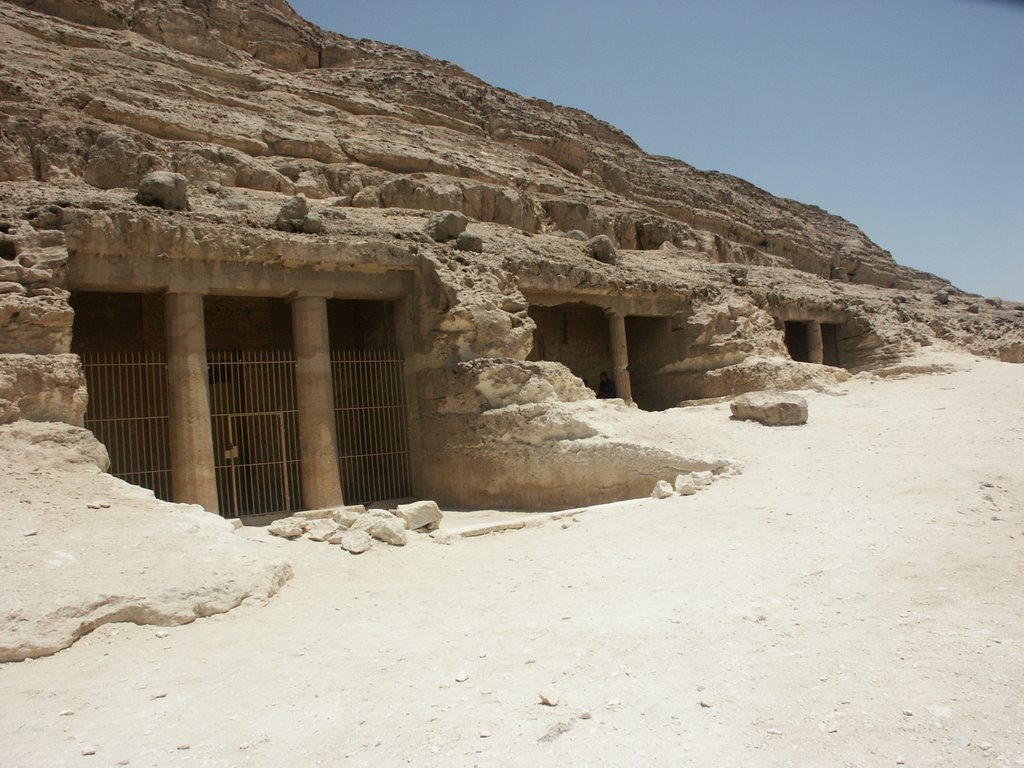
The Beni Hasan Tombs, a series of rock-cut tombs located in the Middle Egypt region, date back to the Middle Kingdom period (c. 2055-1650 BC).
These tombs provide invaluable insights into the daily life, activities, and social structure of ancient Egypt’s provincial elites. The tombs feature remarkable scenes and inscriptions that depict hunting, farming, fishing, and various aspects of daily life, along with detailed biographical information about the tomb’s occupants.
The art in these tombs is known for its vivid representations of life during the Middle Kingdom, giving us a unique window into the lives and aspirations of non-royal individuals in ancient Egypt.
16. The Egyptian Obelisks: Symbols of Power and Divinity
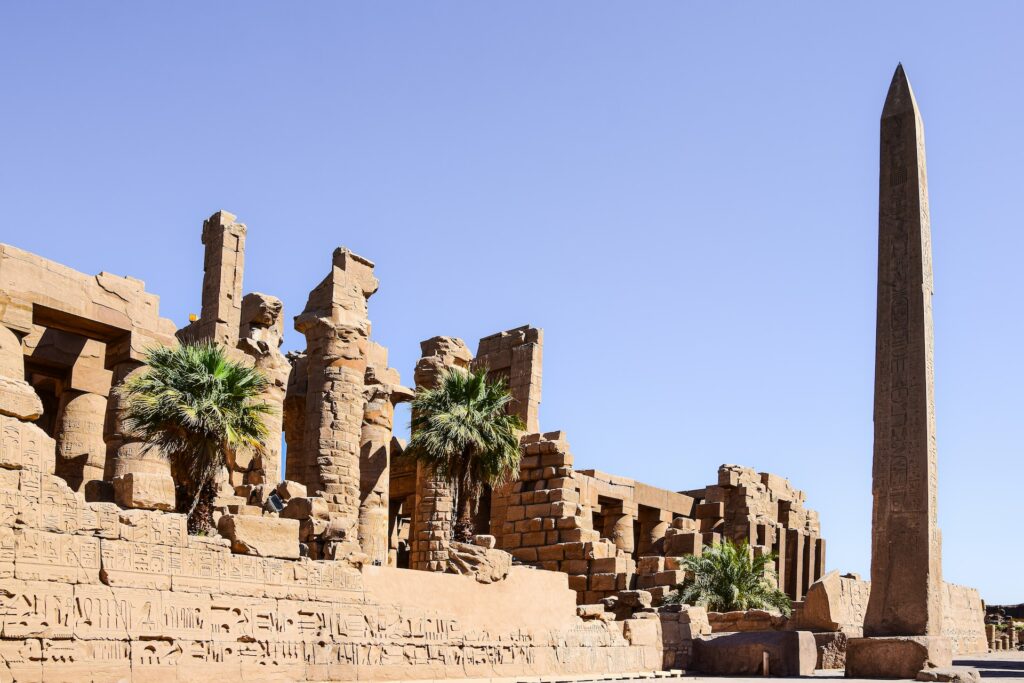
Egyptian obelisks are tall, slender monuments with inscriptions, often seen in pairs, that have fascinated people for thousands of years. These iconic structures are known to date back to the Old Kingdom (c. 2686-2181 BC).
Obelisks were typically constructed from a single piece of stone and were often carved with hieroglyphs honoring pharaohs and gods. They were placed in pairs at temple entrances, serving as symbols of power and divinity. The obelisk of Hatshepsut at Karnak and the obelisks in front of the Luxor Temple are renowned examples of this unique Egyptian architectural form.
These timeless monoliths continue to stand as reminders of the grandeur and spirituality of ancient Egypt, even as they grace the cityscapes of modern-day Egypt and other parts of the world.
17. The Colossal Red Granite Statue of Amenhotep III: A Monument to Majesty
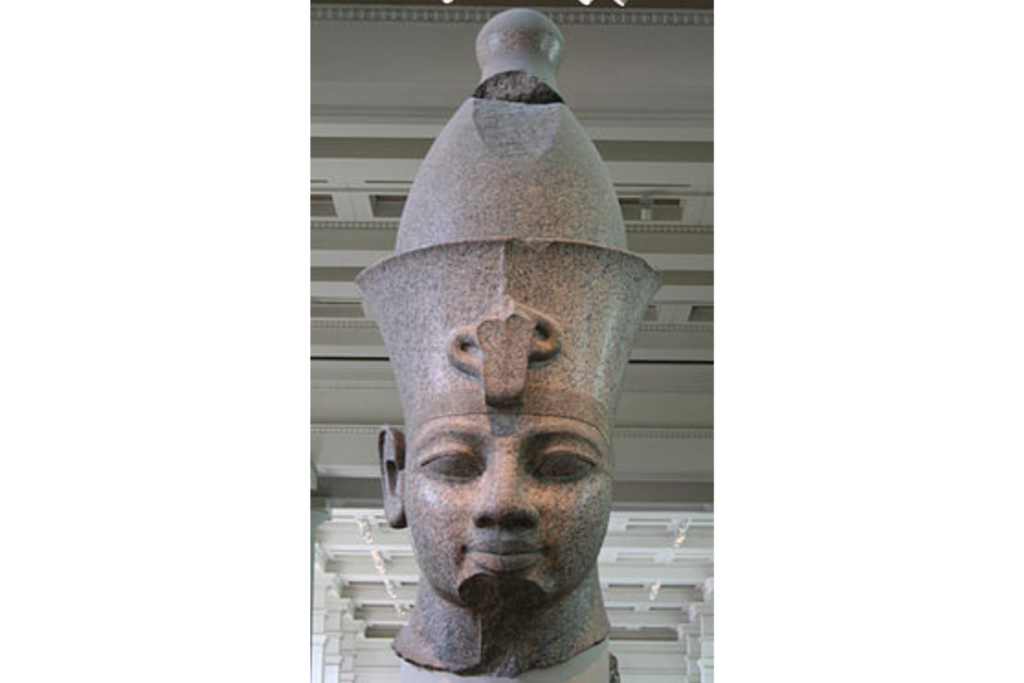
The Colossal Red Granite Statue of Amenhotep III is an imposing piece of ancient Egyptian art. It was discovered in the Theban necropolis and dates back to the reign of Pharaoh Amenhotep III, who ruled during the 14th century BC.
This immense statue, made from a single piece of red granite, stands as a testament to the grandeur and power of this pharaoh. It originally adorned his mortuary temple on the west bank of the Nile in Thebes and was designed to depict the king in a seated position.
This statue, which stands at around 18 feet in height, is a striking example of ancient Egyptian sculpture, showcasing the exquisite craftsmanship of the time and the significance of monumental art in commemorating and venerating pharaohs.
18. The Sekhmet Statues: Guardians of Divine Wrath
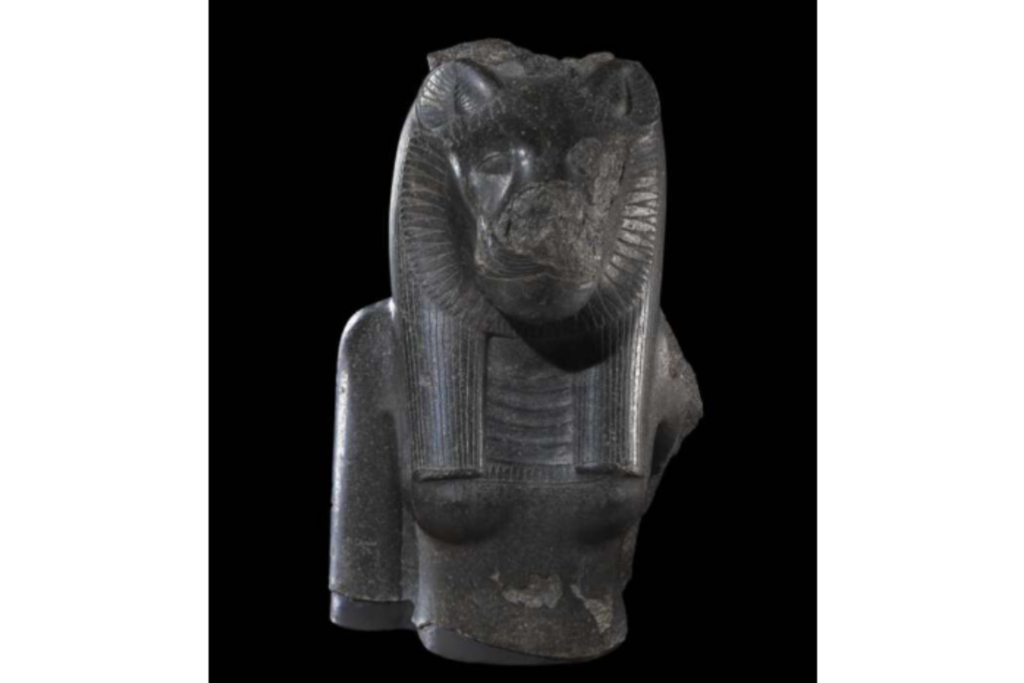
Sekhmet, the lion-headed goddess of ancient Egyptian mythology, was both a protector and a bringer of divine wrath. Numerous statues of Sekhmet have been discovered throughout Egypt, with some dating back to the New Kingdom period (c. 16th-11th centuries BC).
These statues often portrayed her with a lioness head and a human body, holding a sun disk and an ankh (symbol of life). Sekhmet was associated with healing, but she was also the goddess of war and destruction.
Statues of Sekhmet were placed in temples and tombs to invoke her powers of protection and healing or to avert her anger. Her presence symbolized the balance between nurturing and fierce aspects of the divine.
19. The Coffin of Nesykhonsu: A Glimpse into the Late Period
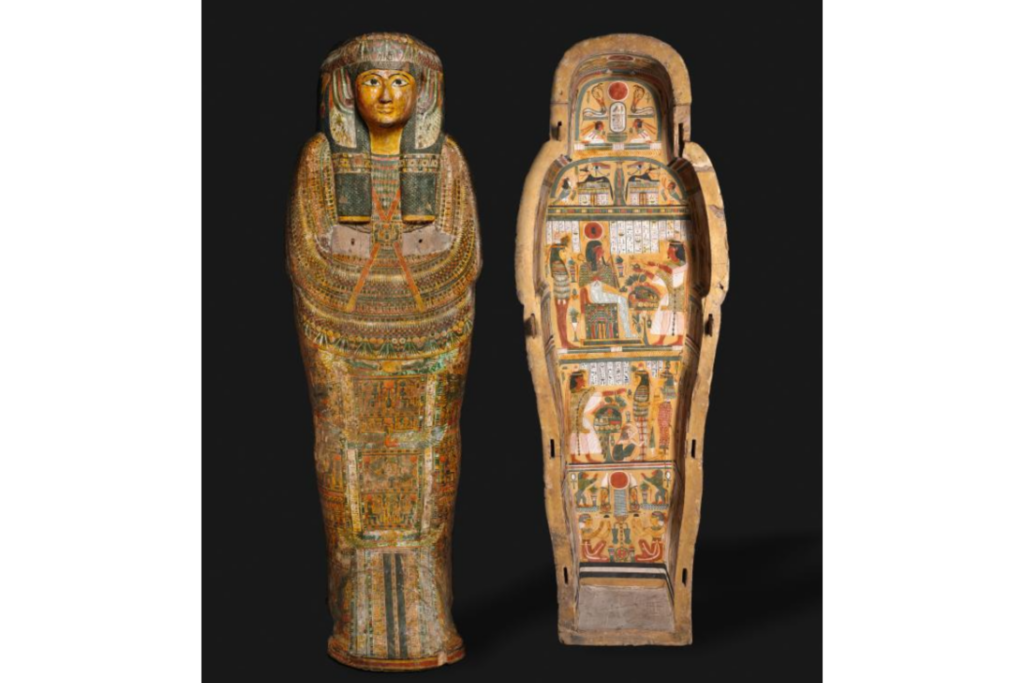
The Coffin of Nesykhonsu, hailing from the Late Period (c. 664-332 BC), is a finely decorated funerary coffin that was unearthed in ancient Thebes. It is an exquisite example of the craftsmanship and religious beliefs of that time.
This wooden coffin was adorned with intricate carvings and hieroglyphs, highlighting the reverence for the afterlife and the meticulous preparation for one’s journey to eternity.
The coffin of Nesykhonsu, like many others of its era, is a testament to the enduring cultural and religious traditions of ancient Egypt, offering insight into their complex mortuary practices.
20. The Shabti Figures: Servants for the Afterlife
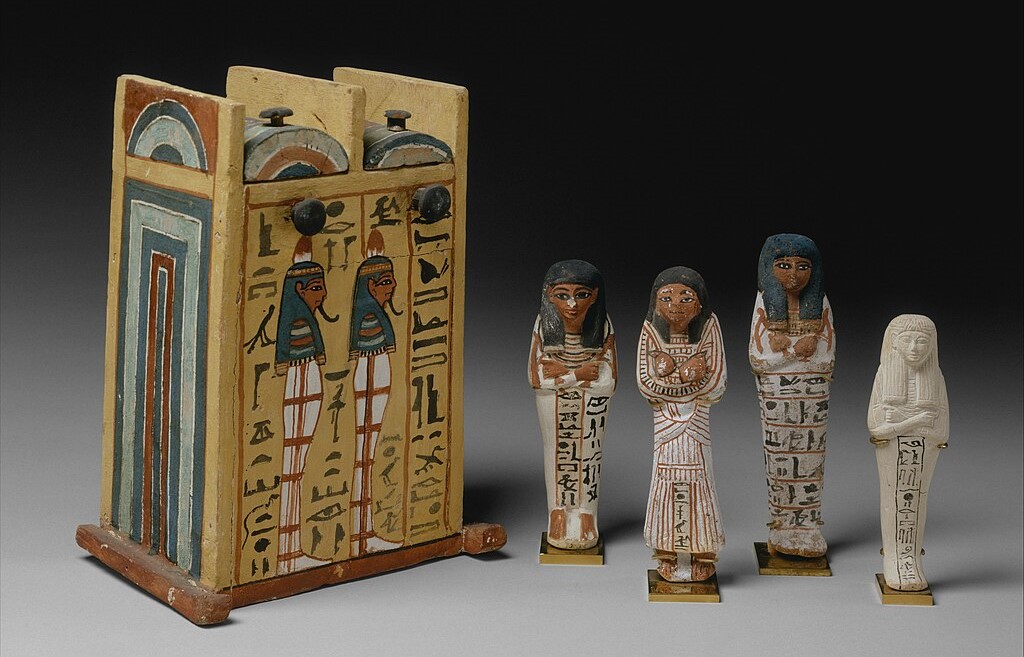
Shabti figures, also known as ushabti or shawabti, are small figurines placed in tombs to serve the deceased in the afterlife. These statuettes date back to various periods of ancient Egyptian history, but they became particularly popular during the New Kingdom (c. 16th-11th centuries BC).
Shabtis were created in multiples, often numbering 365, to represent each day of the year, and were intended to perform labor for the deceased in the hereafter. The belief was that these figurines would come to life and undertake any necessary tasks, relieving the deceased from physical toil.
Shabti figures are a fascinating manifestation of the Egyptians’ spiritual commitment to the concept of an afterlife and their meticulous preparation for the eternal journey.
Conclusion
The ancient Egyptian civilization, with its rich tapestry of art, architecture, and religious practices, has left a lasting legacy that continues to captivate the world. From the grandeur of colossal statues to the intricacy of finely decorated coffins, and from the imposing presence of pharaohs to the fierce protection of lion-headed goddesses, these artifacts are more than just relics of a distant past; they are portals into a world where life and death, power and devotion, and the temporal and the eternal were intertwined.
These ancient Egyptian artifacts bear witness to a civilization that revered the afterlife, celebrated its rulers, and sought to harmonize human existence with the divine. They illuminate the profound spiritual beliefs, artistic excellence, and engineering feats of an extraordinary people. Each artifact tells a unique story of a society that left an indelible mark on the annals of history.
As we gaze upon these treasures, we are reminded that while the sands of time may have covered the ancient world, its echoes continue to resonate in these captivating relics. The enduring appeal of these artifacts serves as a testament to the enduring fascination with the land of the pharaohs, where history, art, and spirituality converged to create a civilization that still enchants and inspires us today.






